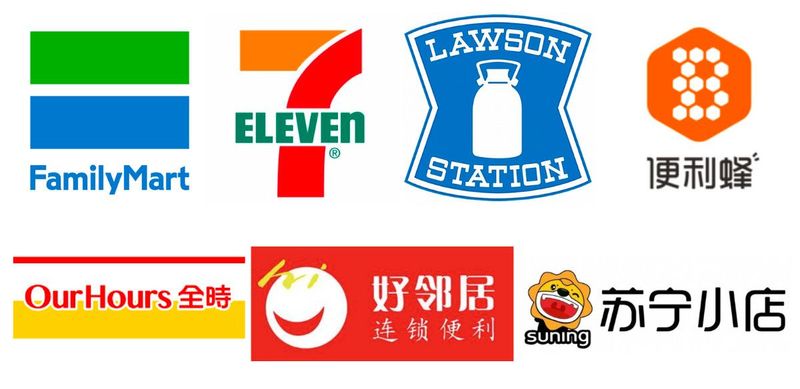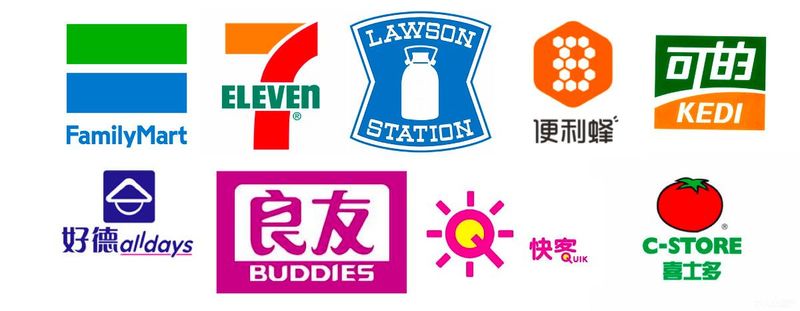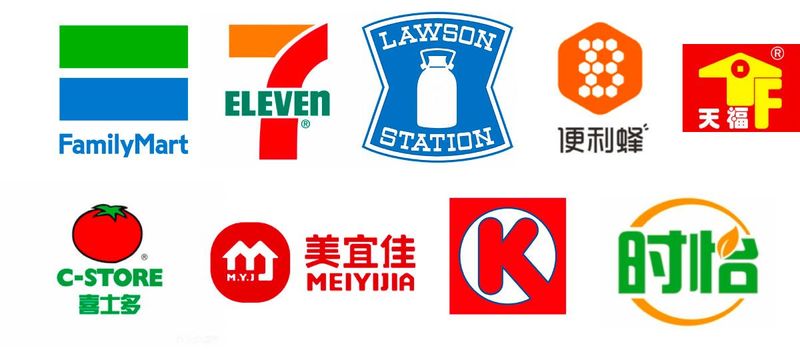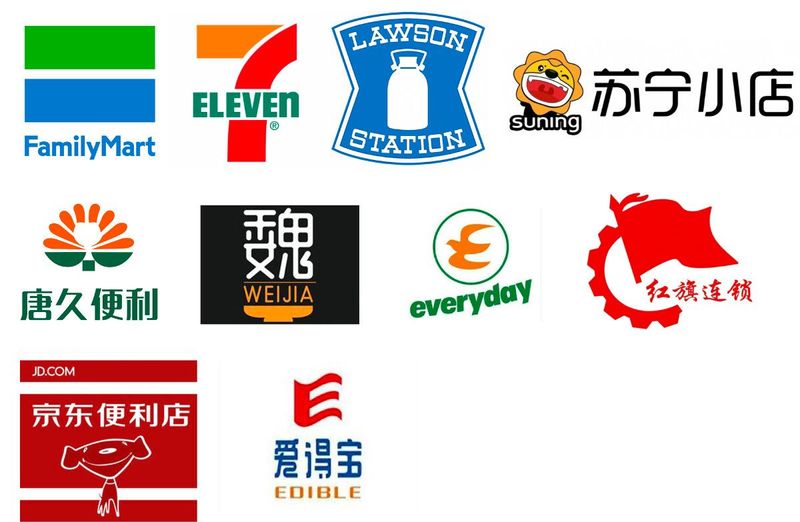type
status
slug
summary
tags
category
icon
password
ID
date
Author
URL
Convenience stores have a special status in Asia.
Because of the dense population and crowded workplaces, convenience stores are necessary places for people to gain food, daily supplies and short breaks.
Around the world, there are many well-known convenience store brands, such as 7-11, CU and Lawson, but they all seem to be from Japan or South Korea.
With the process of urbanization, there are more and more convenience stores in China. By the end of 2018, there were over 122,000 convenience stores in the mainland.
In China, why do the industry have such a development?
Before the convenience store appeared in China
Like many things in China, the very beginning of Chinese convenience stores can be traced back to the early days of reform and opening up. At that time, the term “convenience store” did not even exist in Chinese. At that time, people called the shops on the street selling packaged food, drinks, and other small goods as “Xiao Mai Bu”.
Xiao Mai Bu(小卖部) is an individual business born in the early days of reform and opening up. Unlike the later convenience store, it usually does not have any brand and is established by local residents in the community.
It literally means “very small shop” or “tiny selling department” in Chinese.
The location of Xiao Mai Bu is also different from that of later convenience stores. It is often set up in hutongs or alleys, or in front of the school gate. Many Xiao Mai Bu are transformed from bungalows, which simply means that a resident living in a bungalow opens a door or window in one of the walls of the room and provides services to consumers as a small shop.
So the operators of Xiao Mai Bu are usually the neighbors of customers.
In the 1990s, large-scale changes have taken place in China’s economic system. Many employees who used to work in state-owned enterprises were forced to leave, and as a result, they had to start their own business for a living. It was easier for urban residents to open a community store because it cost less and only needed to renovate one room of their own house or apartment.

A restored Xiao Mai Bu scene in a retro-themed pop-up store in 2019.
As a result, Xiao Mai Bu feels more friendly than later convenience stores. It allows customers to bargain or even buy on credit. Some Xiao Mai Bu will put fans, televisions, tables and chairs in front space of the door, and people will gather at there to eat snacks, drink beer and chat together after work. Some Xiao Mai Bu operators also help neighbors look after their children after school, because students usually end school earlier than parents get off work.
It was once thought that convenience stores could not succeed in China because of Xiao Mai Bu. Because it offers more services that a pure commercial industry could never do. More importantly, it is part of the Chinese community, not just a store.
But with the improvement of urbanization, Xiao Mai Bu fell into its own problems.
First of all, there is no guarantee for the quality of the goods sold by Xiao Mai Bu because of the lack of unified brand and difficulties in supervision. Although Xiao Mai Bu operators tend to be trusted by the local community, this does not mean that the operators themselves will not be deceived. These self-employed are often middle-aged or even elderly couples, they lack the ability to identify inferior goods, which leads to many food safety problems.
The problem is particularly obvious in those near schools and parks, where the keyword “Xiao Mai Bu” is used to search for news from the early 21 century. The main content is the sale of shoddy products and unhygienic food in Xiao Mai Bu.
Secondly, with the development of economy, Xiao Mai Bu has gradually become a tool for power rent-seeking.
As mentioned above, the earliest site selection of Xiao Mai Bu is usually the residents’ own property. However, with the demolition of bungalows in the development of the city, Xiao Mai Bu practitioners have to rent storefronts to operate. Some places where are particularly suitable for opening Xiao Mai Bu, such as campuses and parks, have begun to rent out storefronts at very high prices. There may also be corruption in these transactions, which has completely changed the living environment of Xiao Mai Bu.
Furthermore, with the large-scale population mobility and the improvement of the level of urbanization, Xiao Mai Bu has lost its former use as a member of the community. Young people who come from small cities or villages to big cities and live in rented apartments do not establish an emotional connection with a “store” or spend their time on Xiao Mai Bu. For them, it is just a store for buying goods, which makes Xiao Mai Bu lose its symbolic features in first-tier cities.
“Mainstream” convenience stores in China
In fact, the mass disappearance of Xiao Mai Bu in first-tier cities may not be until 2008, but the entry of convenience stores was as early as 1993.
In 1993, the first convenience store appeared in Shanghai since the founding of the people’s Republic of China. The convenience store is called “BaiShi”(百式) and is controlled by Hong Kong businessmen.
At that time, the opening of the BaiShi convenience store in Shanghai attracted the attention of the Chinese media and consumers, and the Shanghai Xinmin Evening News reported the message on May 3 of that year. In the report, it was described as “the first convenience store in China to adopt the’7-11 business model'” and highlighted the difference from Xiao Mai Bu: it opened 24 hours a day, it sold coffee and sandwiches, and it also provided a microwave oven to heat food.
However, because there was no Internet Alarm System and security cameras at that time, the convenience store would lock the door at night, leaving a takeout window, so consumers could only buy goods from the takeout window.
You are reading Panda!Yoo
A blog about modern Chinese culture and consumption trends. If you are interested in Chinese food, drinks, games, movies, novels, dramas, please follow us.
Join 1,565 other subscribers
In 1995, the Chinese government launched a campaign to transform “grain stores” into convenience stores. The background here is worth mentioning. During that time, the Chinese government transformed many former government departments into enterprises in order to thoroughly promote the market economy, and the food distribution system was one of them.
Before the reform and opening up, the Chinese could only exchange basic foods such as grain and cooking oil from state-owned grain stores. But with the development of the market economy, people can buy these things in vegetable markets, supermarkets and other stores. As a result, the public grain stores of the past were no longer needed.
The campaign to transform state-owned grain stores into convenience stores has been a phased success, bringing the number of convenience stores in China to 20,000 within a few years. Such convenience stores were gradually transformed into independent brands and formed their own factions in different regions. In Shanghai, for example, the BUDDY convenience store chain established in 1998 is transformed from the local grain stores of the past.
It is worth mentioning that the Chinese name of “The Buddy” is 良友 (good friends), and its pronunciation in Chinese is similar to that of grain and oil(粮油).
Lawson entered Shanghai market in 1996, Family Mart entered Shanghai market in 2004, and 7-11 entered Beijing market in 2004.
With the entry of three major international convenience store chain brands into the Chinese market, the industry has formed a stage of common development of urban local brands and cross-regional international brands.
In China, you will find such a situation: you can find Lawson, Family Mart and 7-11 in all the first-tier cities, yet they are not the most common convenient stores in any city.
City or Region
The convenience store you will often see
Beijing

Shanghai

Guangdong Area
(Including Guangzhou, Shenzhen and other cities)

Northwest region
(Including Shaanxi and Gansu provinces)

Popular convenience stores in some parts of China
If you go to Guangzhou (and the whole Guangdong area), you will find that the convenience store with the largest number of stores is MYJ(美宜佳); the more common convenience stores in Shanghai are C-store(喜士多) and the BUDDY(良友); in Beijing and Tianjin were once OurHours(全时); in northwestern cities are Red Flag chain(红旗连锁).
Compared with Lawson, Family Mart and 7-11, these city-based local brands are somewhere between Xiao Mai Bu and convenience stores. They have a unified brand and supply chain, and are often run by local residents. Even similar to Xiao Mai Bu, it is usually run by couples.
As we have mentioned in many articles, China is a vast and complex country. Different provinces and different cities have very different consumption preferences. Regional convenience store chains have more advantages and flexibility than national chains in the selection of products.
Compared with Xiao Mai Bu, convenience stores tend to be located in the workplace rather than in the living areas. It satisfies young people who work in office buildings instead of local residents and students.
This has also spawned a unique service in Chinese convenience stores: mainstream Chinese convenience stores offer hot dishes, such as Kung Pao Chicken and Mapo tofu for lunch and dinner, served with rice. Instead of “Japanese bento” pre-cooked and packaged in the central kitchen, they are cooked by convenience store staff before mealtime, heated and sold continuously in a Buffy stove.
A huge hidden market
So, who is the leader of China’s convenience store industry? It may be inaccurate by only calculating the basis of the number of stores opened.
Gas station-Based convenience store also exists in China. In fact, the two convenience store brands with the largest number of stores in China are Easy Joy and uSmile, which belong to Sinopec and PetroChina, the two largest gas station companies, respectively.
Easy Joy and uSmile have 25700 and 19000 stores in China, respectively.
Even if only counting the traditional convenience store, foreign brands do not monopolize the market. Famiy Mart, 7-11 and Lawson ranked sixth, ninth and 12th respectively. MYJ, which is popular in the south, is the traditional convenience store with the largest number of stores in China. By 2018, it had more than 11609 stores, which was six times that of Family Mart.
According to the 2019 China convenience Store Development report released by the China chain Business Association, there were 122,000 convenience stores in China by the end of 2018. However, for a country with a population of 1.4 billion, this number is still not worth mentioning.
Rank
Name
Description
Number of stores
1
Easy Joy
Convenience stores owned by Sinopec
25700
2
uSmile
Convenience stores owned by PetroChina
19000
3
M.Y.J
Local convenience stores that are popular in Guangdong
15559
4
SuNing Mini Store
It comes from the integration of the second-and third-tier city Xiao Mai Bu by the e-commerce company Suning.
4508
5
TF
Another convenience store popular in Guangdong.
4212
6
Red Flag Chain
A popular convenience store in northwestern cities in China.
2817
7
Family mart
International chain brand
2571
8
ShiZu
Convenience stores popular in the Central Plains and South China.
2141
9
Lawson
International chain brand
1973
10
7-11
International chain brand
1882
11
365
A popular convenience store in North China outside Beijing.
1850
12
TangJiu
Another popular convenience store in the northwest.
1500
13
JianFu
A popular convenience store in Fujian.
1455
14
Quik
Another popular convenience store in South China.
1322
15
EveryDay
Another popular convenience store in the northwest.
1219
The number of convenience stores in China ranked as of December 31, 2018. via CCFA
Despite we introduced the failure of Xiao Mai Bu in China’s first-tier cities earlier, until now, brandless Xiao Mai Bu is still the main retial pattern in China’s second-tier cities and below. According to the statistical data of industrial and commercial registration of snacks, the number of Xiao Mai Bu in China may exceed 7 million, about 58 times the number of all convenience stores.
[sociallocker id=”5614″]
Of the 6.8 million Xiao Mai Bu, about 30% are located in townships and rural markets, 21% in county-level cities and counties, 25% in third-tier cities, and 16% and 7% in second-and first-tier cities. The total annual sales of Xiao Mai Bu may exceed 10 trillion yuan.
In a statistical report provided by an industrail data base, 87.95% of Xiao Mai Bu’s owners have a degree below high school, while 63.86% are male. However, most of the shopkeepers are not the middle-aged and elderly in the stereotype. 42.17% of the group are under the age of 30, which is six times that of over 50.
Sixty% of these Xiao Mai Bu are jointly run by husband and wife, and nearly 30% choose to open their own shop because they “do not want to work for others”; 25% of “children go to school here” and “children are too young to make money while looking after their children”; and the total percentage of “stable and low risk” is 17.14%.
In terms of operation, more than half of Xiao Mai Bu’s annual income is less than 100,000 yuan, accounting for 53.01%,100,000 ~ 200,000 accounting for 33.73%, 200,000~ 300,000 accounting for 6.02%, and less than 8% of over 300,000 yuan.
Some companies that have little relation with convenience stores are trying to enter the market through these Xiao Mai Bu. For example, Chinese e-commerce giants Alibaba, JD.com, and Chinese express delivery giant Shunfeng all set up relevant business units around 2016.
They are trying to integrate the Xiao Mai Bu in third-tier cities and rural areas. While turning these Xiao Mai Bu into convenience stores, these companies will also acquire the ability of promoting brand, and receipting and dispatching goods.
In first-tier cities, the rank of convenience stores is also changing rapidly. Founded in 2016, Bianlifeng has opened 1500 stores in less than three years. Although the latest industrial rank has not yet been released, this alone means it will exceed the number of 7-11 stores in China. It announced in September 2019 that it planed to open 10, 000 stores by 2021.
Bianlifeng learn from the development path of Luckin-Style, which uses large-scale financing to increase the number of stores. Although the company claims to be profitable based on operating costs. But if counting the fixed cost of opening of new stores, the company is still in massive losses. This rapid occupation of the market by relying on financing is a common stragety for Chinese internet start-ups, but it is rare for traditional industries.
Obviously, this will have an impact on those traditional convenience store brands, especially those international brands that operate across regions.
However, according to the analysis of China Galaxy Securities, if you compare the population density of Japan and South Korea, China’s convenience store market may reach 490,000 in the future.
In January 2020, China’s Ministry of Commerce and other six departments issued a document specifically to promote the development of chain convenience stores. Because chain convenience stores have benefits in many ways, it can promote the community economy, reduce food safety problems, and even solve the employment problem to a certain degree.
Since the opening of China’s first convenience store in Shanghai, the industry has developed for 27 years in this country, however, opening a new store in China is still a good business.
[/sociallocker]
- Author:NotionNext
- URL:https://pandayoo.com/2020/07/20/a-brief-history-of-convenience-stores-in-china
- Copyright:All articles in this blog, except for special statements, adopt BY-NC-SA agreement. Please indicate the source!